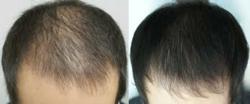Navigation
Hair Loss News Archives
April 2013
Southwest Skin and Cancer Institute Offers PRP Therapy for Hair Restoration
Robin Fleck, M.D. founder and medical director of Southwest Skin and Cancer Institute announces the arrival of a new treatment to regrow hair.
Platelet rich plasma therapy (PRP) is the process of separating blood platelets from a patient’s blood and placing them back into the scalp.
Blood platelets contain growth factors which attract stem cells into the area of hair loss. Stem cells and platelet growth factors can stimulate regrowth of hair.

Hair loss is caused most commonly by androgenetic or hereditary alopecia which leads to miniaturization of the hair follicle and the result is thinning of the hair.
In women, complete baldness rarely occurs; however in men, the miniaturization frequently progresses to complete loss of the hair follicles.
Where hair follicles are still present, PRP can restore the hairs to their original size and improve hair thinning. For this reason, PRP works best in women or in younger men who have just started to notice thinning of their hair.
Diseases such as alopecia areata, in which the immune system attacks the hair follicles, causes patchy hair loss. This condition also responds to PRP treatment. However hair loss due to chemotherapy or radiation is unlikely to respond to PRP.
Up to now, hair loss has been treated with medications such as Rogaine and Propecia, and hair transplantation. In addition, low energy laser therapy such as LaserCap has shown benefit in stimulating and maintaining hair growth. “In my experience, Rogaine alone has not been very effective in restoring hair loss; however in combination with PRP, a synergistic effect has been demonstrated,” notes Dr. Fleck. “It’s exciting to be able to offer patients an affordable and effective alternative to hair transplantation.”
Blood consists of only 6% platelets. Platelets are important for blood clotting because they release a cascade of chemical factors which stimulate clot formation when tissue has been injured. Platelets also contain growth factors which are released at areas of injury to repair damaged tissues.
PRP therapy requires 60 mL of blood to be drawn from the patient’s arm. Platelets are then concentrated by centrifugation of the blood. The scalp is numbed with local anesthesia and the platelet rich plasma is placed into the scalp through multiple tiny injections.
The large numbers of platelets, when injected back into the patient, promote healing while accelerating the rate and degree of regeneration. The purpose is to stimulate inactive hair follicles into an active growth phase. The scalp may tingle for a few hours and swelling may be seen for up to 4 days.
Patients that have undergone PRP therapy have observed enhanced hair growth and thickness within 3-6 months. Platelet rich plasma therapy poses no risk for allergies, hypersensitivity or reactions to foreign bodies since the platelets are derived from the patient’s own blood.
PRP is not for everyone. Patients who have been diagnosed with low platelet syndromes, chronic liver disease, cancer, clotting problems or who are currently on anti-coagulation therapy should not undergo this procedure. Also, those who smoke heavily and use alcohol are not ideal candidates for the procedure. Anti-inflammatory medications block platelet activity so these should be discontinued for several weeks before PRP.
Cosmetic dermatologist, Robin Fleck, M.D., is a double board certified dermatologist and internist, recognized by the American Board of Dermatology and the American Board of Internal Medicine. She is founder and Medical Director of Southwest Skin and Cancer Institute and Body Oasis Laser Aesthetics http://www.rejuvadoc.com.
Dr. Fleck is a fellow of the American Society of Laser Medicine and Surgery and the American Academy of Dermatology. Dr. Fleck is also the director of Vein Specialties in Prescott, Arizona and is a member of the American Venous Forum.
